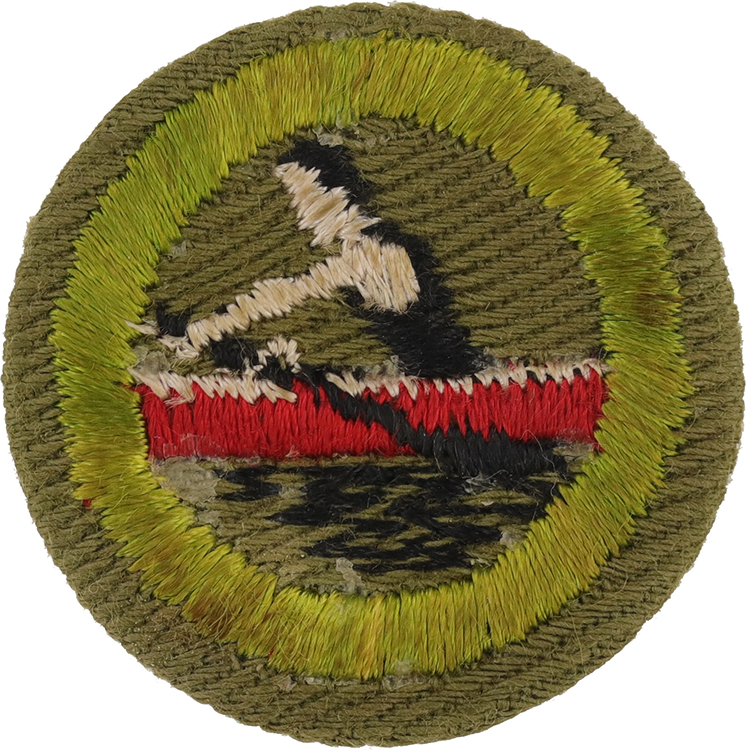
Fig. 1: Rowing-E2-Front
- Cloth: Khaki right twill
- Embroidery: Cotton lock stitch
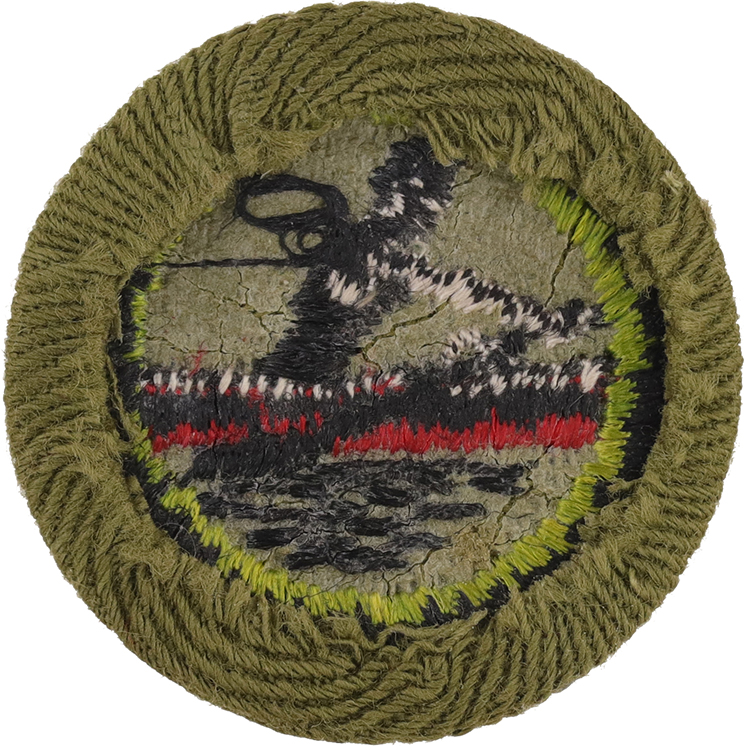
Fig. 2: Rowing-E2-Reverse
- Back: Plain NO imprint with starch
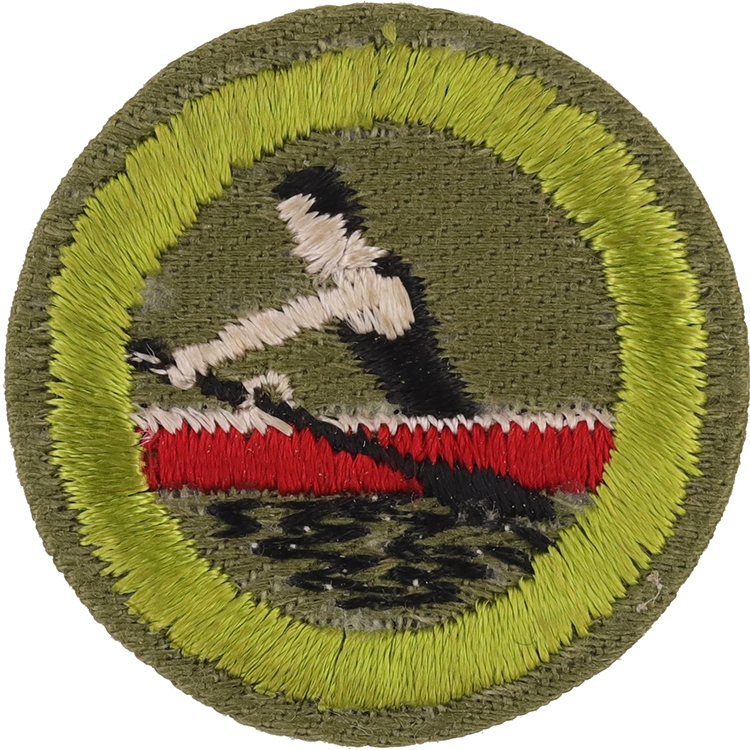
Fig. 3: Rowing-E2-mve1-front
- Minor variation: Shallow depth canoe
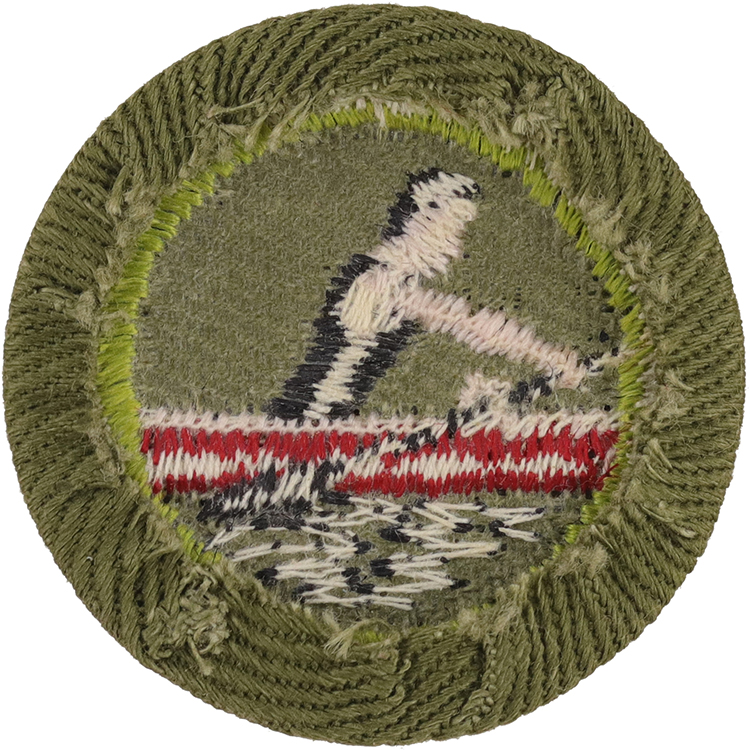
Fig. 4: Rowing-E2-mve1-reverse
- Back: Plain NO imprint with starch
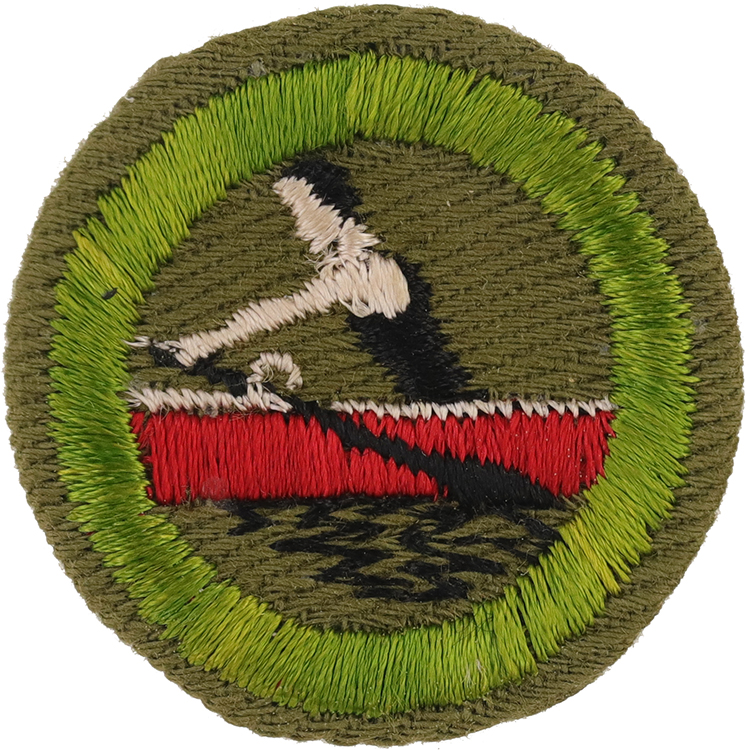
Fig. 5: Rowing-E2-mve2-front
- Minor variation: Deep canoe
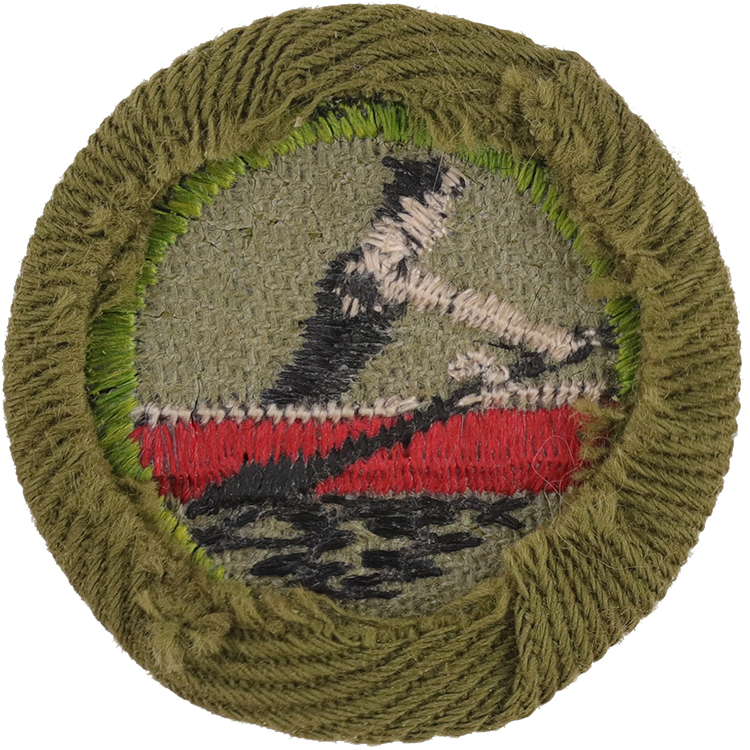
Fig. 6: Rowing-E2-mve2-reverse
- Minor variation: Black lock stitch, plain NO imprint with starch
Item Name: Rowing 1947 - 1957
Item ID: Rowing-E2
Collector Rating: 1
Requirements July 1933 until June 1952
A Scout must first have met the Merit Badge requirements for Swimming, and must:
1. Row properly without assistance, but with Counselor in stern sheets:
(a) In straight line for quarter of a mile, make turn to starboard in boat's length (pivot), and return to starting place.*
(b) Make port turn in boat's length, row quarter of a mile and backwater in straight line to starting place.*
2. (a) Launch and land a rowboat properly from and to shore.
(b) Bring rowboat alongside pier, properly assist a passenger into boat, row fifty feet, pivot, come back to pier and assist passenger safely and properly from boat.*
(c) Make rowboat fast to pier properly, using clove hitch, two-half hitches, and bowline.
3. Alone in a rowboat, shove off from shore or pier; approach swimmer simulating distress, and maneuver boat in such manner that swimmer may grasp and hold stern of boat while being towed ashore.
4. Sketch roughly: (a) Two of the following types of boat selected by his Counselor: Fisherman's Dory, St. Lawrence Skiff, Mississippi River John Boat, Ship's Long Boat, Punt, and Dinghy.
(b) Two of the following types of rowlock selected by his Counselor and give reason why pin rowlock is not desirable; tholepin, box rowlock, ring rowlock, open top rowlock.
5. Be generally familiar with rowing and rowboats and be able to explain clearly (in presence of Counselor and others if possible), how he would handle a rowboat if caught in a sudden storm or high wind; the value of feathering oars; how to calculate number of persons who may safely be carried in any given life boat under oars; using U.S. Steamship Inspection formula; what lights are required on a rowboat at night, with and without outboard motor; how to put rowboat up for winter and prepare it for use in spring.
* Note: Oars used must not be over 7½ feet long, and must be properly feathered on recovery after each stroke. Pin type rowlock may not be used. If a quarter mile straight-away is not available, shorter course may be used, Scout rowing back and forth in a straight line until a quarter mile has been traversed.
Requirements June 1952 until June 1954
1. Row properly without assistance, with your Counselor in stern:
a. In a straight line for a quarter of a mile*, stop, make a pivot turn, and return to starting place.
b. Back water in a straight line 220 yards. Make a turn under way, still backing water and return to the starting point.
(Use oars not over 7¼ feet long. Feather after each stroke. Pin rowlocks may not be used.)
2. Demonstrate how to launch and land as follows:
a. Launch and land a rowboat properly from and to shore.
b. Bring rowboat alongside pier, properly assist a passenger into it, row 50 feet, stop, pivot, come back to pier, and assist passenger safely from the boat.
c. Tie a rowboat to a pier: (1) using a clove hitch; (2) two-half hitches; (3) a bowline.
3. Alone or with one other person, turn a swamped rowboat right side up, get in, and paddle it for 10 yards with your hands or an oar. Tell why you should hang on or get in a swamped boat.
4. Alone in a rowboat, shove off from shore or pier; approach a swimmer and maneuver boat so that the swimmer may hold on to the stern while he is being towed ashore.
5. Identify and describe:
a. Two or more the following types of boats: Fisherman's Dory, St. Lawrence Skiff, Mississippi River John Boat, Ship's Long Boat, Punt and Dinghy.
b. Carvel and clinker type of planking.
c. Two of the following types of rowlocks: tholepin, bow rowlock, ring rowlock, open top rowlock. Give one or more reasons why pin type rowlocks are not recommended.
6. Explain the advantages gained by feathering oars while rowing, and answer any two of the following questions:
a. How would you handle a rowboat if caught in a sudden storm or high wind?
b. How would you calculate the number of persons who may safely be carried in any given life boat under oars, using U.S. Steamship Inspection formula?
c. What lights are required on a rowboat at night, both with and without outboard motor?
d. How would you haul out and stow away a rowboat which is not to be used during the winter, and how would you prepare it for use in the spring?
-------
* If a quarter mile straight course is not available, shorter courses may be used. The Scout will then row back and forth in a straight line until a quarter mile has been covered.
+ A Second Class Scout must first qualify for First Class Scoutcraft requirement 5 (see page 113).
5. GO SWIMMING
SWIMMING*--Tell what precautions must be taken for a safe swim. Jump feet first into water over your head in depth. Swim 50 yards. During the swim, stop, make a sharp turn, level off and resume swimming.
Requirements June 1954 until September 1961
1. Row properly without assistance, with your Counselor in stern:
(a) In a straight line for a quarter of a mile*, stop, make a pivot turn, and return to starting place. (b) Back water in a straight line 220 yards. Make a turn under way, still backing water and return to the starting point.
(Feather after each stroke. Pin rowlocks must not be used.)
2. Demonstrate how to launch and land as follows:
(a) Launch and land a rowboat properly from and to shore. (b) Bring rowboat alongside pier, properly assist a passenger into it, row 50 feet, stop, pivot, come back to pier, and assist passenger safely from the boat. (c) Moor a rowboat using (1) clove hitch, (2) two half hitches, (3) a bowline.
3. Alone or with one other person, turn a swamped rowboat right side up, get in, and paddle it for 10 yards with your hands or an oar. Tell why you should hang on or get in a swamped boat.
4. Alone in a rowboat, shove off from shore or pier; approach a swimmer and maneuver boat so that the swimmer may hold on to the stern while he is being towed ashore.
5. Identify and describe:
a. Two or more the following types of boats: fisherman's dory, St. Lawrence skiff, Mississippi River John boat, ship's longboat, punt, and dinghy;
(b) carvel and clinker type of planking;
(c) two of the following types of rowlocks: tholepin, bow rowlock, ring rowlock, open top rowlock. Give one or more reasons why pin type rowlocks are not recommended.
6. Explain the advantages gained by feathering oars while rowing and answer any two of the following questions: (a) How would you handle a rowboat if caught in a sudden storm or high wind? (b) How would you calculate the number of persons who may safely be carried in any given life boat under oars, using a U.S. Steamship Inspection formula? (c) What lights are required on a rowboat at night, both with and without outboard motor? (d) How would you haul out and stow away a rowboat which is not to be used during the winter, and how would you prepare it for use in the spring?
-------
* If a quarter-mile straight course is not available, shorter courses may be used. The Scout will then row back and forth in a straight line until a quarter mile has been covered.
+ A Second Class Scout must first qualify for First Class Scoutcraft Requirement 5 (see page 113).
5. GO SWIMMING
SWIMMING*--Tell what precautions must be taken for a safe swim. Jump feet first into water over your head in depth. Swim 50 yards. During the swim, stop, make a sharp turn, level off and resume swimming.


